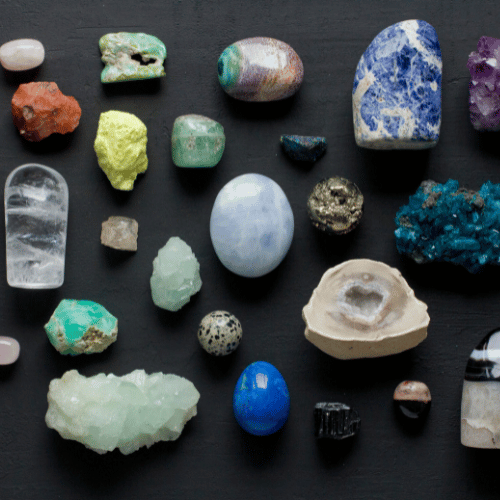Pyrite, commonly known as "fool's gold," is a mineral with a distinctive golden sheen that has fascinated humans for centuries. Its resemblance to gold has fooled many explorers and collectors. But how do you make sure the pyrite you have is real? This guide will teach you how to easily identify real pyrite.
What is Pyrite?
Before getting into the specifics of how to identify real pyrite, it's important to understand what pyrite is. Pyrite is a naturally occurring iron sulfide (FeS2) mineral, known for its brassy-yellow color and metallic luster. It forms in a variety of geological environments, making it a prevalent mineral in the Earth's crust.
Physical Properties of Real Pyrite
First, it is important to know the physical properties of pyrite for identification:
Color and Luster: Real pyrite usually displays a brassy yellow color, which can sometimes appear slightly yellow or silvery. Its metallic luster is one of its most distinctive features, making it shine like real gold.
Crystal Shape: Pyrite often forms cubic crystals, but it can also appear as octahedrons and icosahedrons. These shapes vary and can help you identify real pyrite from other minerals.
Streak Test: A quick and straightforward way to distinguish pyrite from real gold can be a streak test. When scratched onto an unglazed porcelain plate, pyrite leaves a greenish-black streak, while gold leaves a yellow streak.
Hardness: On the Mohs scale of mineral hardness, pyrite is rated around 6 to 6.5. This means it can scratch glass and is harder than most other common minerals. In contrast, gold is much softer, with a Mohs hardness of about 2.5 to 3.
Density and weight: Although pyrite is heavier than most minerals, it is significantly less dense than gold. If you compare a piece of real pyrite to an equally sized piece of gold, the gold will appear heavier.
Chemical tests to identify real pyrite
In addition to physical properties, chemical tests can confirm whether a specimen is real pyrite:
Sulfur odor: When real pyrite is struck or heated, it gives off a sulfur odor. This is caused by the breakdown of iron sulfide into iron and sulfur compounds.
Acid test: Real pyrite reacts with acids to form weak sulfuric acid and iron ions. For this test, a drop of diluted nitric acid is placed on the mineral. If it is real pyrite, there should be little or no reaction. Be cautious with this method, however, as it can damage the specimen and should be performed with proper safety precautions.
Magnetic testing: Pyrite is not magnetic, so if you have a magnet, try to attract the specimen. If the specimen is very magnetic, it is probably not pyrite.
Visual and textural signs
When learning to identify genuine pyrite, visual inspection plays an important role:
Surface texture: Genuine pyrite often has visible striations (fine parallel lines) on its crystal surfaces. These striations are unique to pyrite and can help distinguish it from gold, which usually has a smooth surface.
Tarn: Over time, genuine pyrite may develop a tarnish, which appears darker and less lustrous. This tarnish may also be green, brown or red in color, indicating the presence of iron oxide on the surface.
Fractures and cracks: Genuine pyrite has a conchoidal (shell-like) fracture and does not break easily. It can break into small, sharp pieces, unlike gold, which bends and scratches without breaking.
Common Misidentifications
When identifying real pyrite, it is common to confuse it with other minerals, such as:
Marcasite: Similar to pyrite but has a more silvery color and forms differently shaped crystals. Chalcopyrite: Often mistaken for pyrite because of its color, but it is softer and leaves black streaks.
Mica: It can appear golden and shiny, but is much lighter and softer than pyrite.
Tips for Collectors and Hobbyists
For those interested in collecting or using pyrite, here are some additional tips:
Buying from Reputable Sources: Make sure you buy pyrite from reputable dealers or reliable sources to avoid counterfeits.
Handling and Storage: Keep pyrite in a dry place to prevent it from tarnishing. Handle with care, as pyrite can be brittle and break easily.
Documentation: If you are collecting pyrite specimens, document where and how you obtained them. This information can be helpful for future reference or if you plan to resell your collection.
Conclusion
Understanding how to identify real pyrite involves a combination of physical observation, chemical testing, and awareness of common pyrite appearances. With this guide, you can confidently determine if the pyrite you have is real. Use the methods described above to ensure accuracy.
Frequently Asked Questions
1. What is the main difference between pyrite and gold?
The main difference is in their hardness, weight and streak color. Gold is softer, heavier and leaves a yellow streak, while pyrite is harder, less dense and leaves a greenish-black streak.
2. Can pyrite be used as a source of iron?
Yes, pyrite is often used as a source of iron, especially in areas where other iron sources are scarce. However, its primary use is in the production of sulfuric acid.
3. Is pyrite safe to handle?
Handling pyrite is generally safe, but it should be done carefully to avoid inhaling dust particles. It is also advisable to wash your hands after handling pyrite specimens.
---------------------------------
Explore our exclusive Pyrite Collection at Shriprasadam, featuring powerful stones known for attracting wealth, protection, and positive energy. Discover how these unique pieces can enhance your spiritual journey and bring prosperity into your life.























